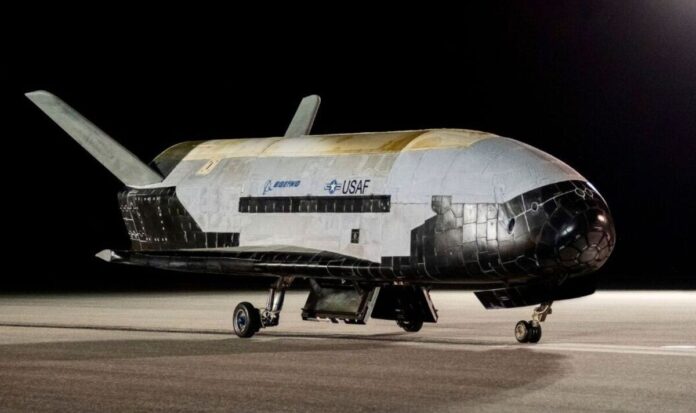An unmanned, solar-powered US military space plane returned from its sixth mission on Saturday, having spent a record-breaking 908 days in orbit. Built by Boeing, the X-37B Orbital Test Vehicle – which resembles a miniature space shuttle – was developed to test space technologies. It was launched on top of a United Launch Alliance Atlas V rocket from the Cape Canaveral Space Force Station in Florida back in May 2020. The craft landed at NASA’s Kennedy Space Center in Florida, the same complex from which the Artemis I Moon rocket will hopefully be blasting off early tomorrow morning.For the first time, the space plane carried a so-called service module designed to increase the total number of payloads it could carry. This carried scientific experiments for partners including the Naval Research Laboratory and the US Air Force Academy.To ensure a safe landing, the module was jettisoned from the vehicle before it left orbit. The space plane and the module then returned to Earth separately.Boeing Space and Launch senior vice president Jim Chilton said: ‘Since the X-37B’s first launch in 2010, it has shattered records and provided our nation with an unrivalled capability to rapidly test and integrate new space technologies.’With the service module added, this was the most we’ve ever carried to orbit on the X-37B and we’re proud to have been able to prove out this new and flexible capability for the government and its industry partners.’ An unmanned, solar-powered US military space plane returned from its sixth mission on Saturday (Image: Boeing / US Space Force) The X-37B is the smallest and lightest space plane yet flown (Image: Creative Commons / Kelvin Case)One of the experiments carried on the X-37B’s latest flight was ‘FalconSat-8’. This microsatellite was designed and built by cadets at the US Air Force Academy.The space plane released the satellite into orbit back in May 2020, where it remains in operation today. FalconSat-8 was developed to test a novel electromagnetic propulsion system, and also sports low-weight antenna technology,Alongside this, it is also carrying three other technological experiments. These include a special form of cabling with carbon nanotube braiding and a flywheel capable of storing and releasing energy.The third experiment, SkyPad, is a device capable of image processing, star tracking, and orbit determination. It was specially developed for low size, weight and power requirements, but was built from off-the-shelf components.READ MORE: NASA’s vital mission will help pave the way for first Mars landing For the first time, the X-37B carried a service module to increase its payload capacity (Image: US Space Force / Staff Sgt. Adam Shanks) In total, the space plane has spent a whopping 3,774 days in orbit (Image: US Air Force)The X-37B was also carrying multiple experiments on behalf of NASA – including the so-called Materials Exposure and Technology Innovation in Space, or METIS-2 for short.This experiment was designed to evaluate the effects of space exposure to various materials, allowing scientists to validate and improve the precision of space environment models. This is the second time such an experiment has been flown into orbit.Another NASA experiment carried on-board the space plane was developed to asses the effects of long-term space exposure on seeds. The findings may be of use when humanity comes to travel to other planets and construct permanent bases in space.The recent flight, commented US Space Force General Chance Saltzman, ‘highlights the Space Force’s focus on collaboration in space exploration and expanding low-cost access to space for our partners, within and outside of the Department of the Air Force.’DON’T MISS:World hits 8bn people as countries with biggest populations unveiled [REPORT]Rishi Sunak urged to ‘immediately’ scrap heat pump payment scheme [INSIGHT]Study claims French people locked in ‘laziness epidemic’ [ANALYSIS] Pictured: A 1999 artist’s impression of the X-37 concept (Image: NASA / Marshall Space Flight Center)NASA commissioned Boeing to develop the X-37 back in 1999, with a total of $192million being spent on the project over the following four years. In 2004. However, the project was transferred over to the US Defense Advanced Research Projects Agency, who created the X-37B variant.The X-37B first flew during a drop test in 2006. Its first orbital mission was then launched in April 2010, returning to the Earth eight months later.Since then, the duration of each mission has been gradually increased. The fifth flight, for example, lasted 780 days, 128 days less than the recent mission.In total, the space plane has spent a whopping 3,774 days in orbit, having flown a grand total of 1.3 billion miles around the Earth.
Solar-powered US military space plane returns from 908-day flight
Sourceexpress.co.uk
RELATED ARTICLES


